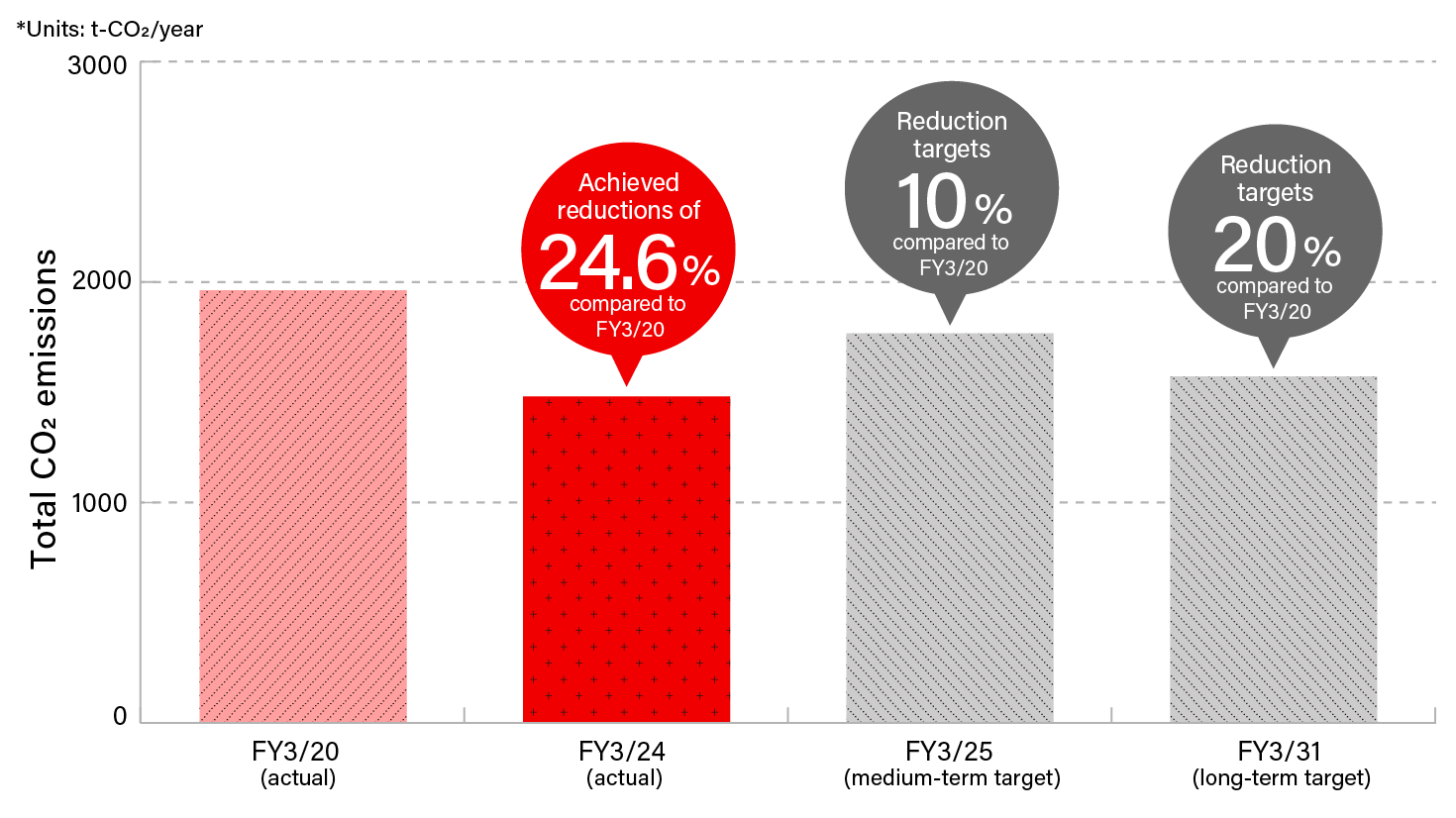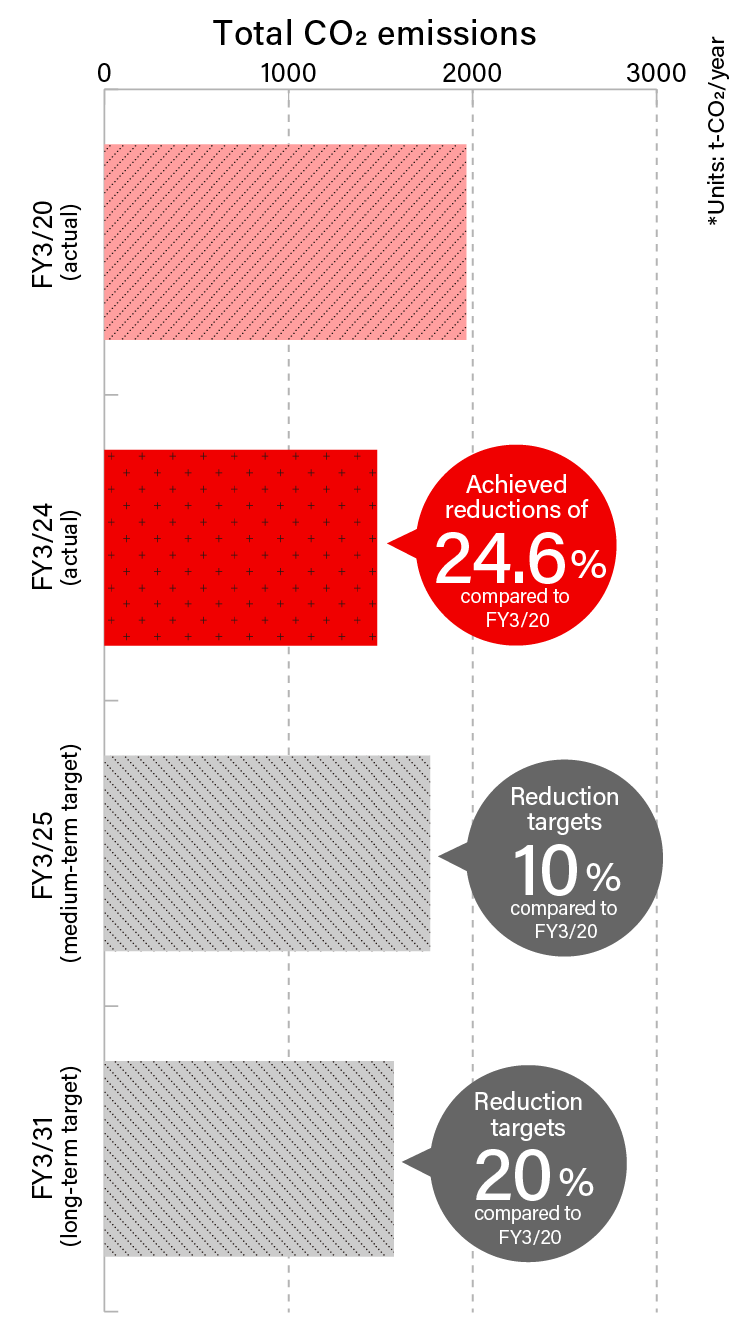Initiatives for the Environment

Environmental policies
In order to sustainably and safely protect the global environment, through reduction of energy use, the Group will proactively take efforts toward addressing climate change, reuse of resources and the conservation of biodiversity.
Initiatives for addressing climate change
Targets
The Group has established a target to “reduce total CO2 emissions by 20% by the fiscal year ending March 31, 2031, compared with the fiscal year ended March 31, 2020.”
This applies to not only the CO2 emitted from the offices, but also CO2 from employee’s business activities and through the service’s entire life cycle. We will perform wide-ranging activities to prevent global warming while working with clients, business partners, and employees.
Initiatives related to Task Force on Climate-related Financial Disclosures (TCFD) Recommendations.
Initiatives for the Recommendations of the Task Force on Climate-related Financial Disclosures (TCFD)
Our approach to climate change, organized by the four core elements, Governance, Strategy, Risk Management, Metrics and Targets, advocated by the TCFD, is as follows.
| 1. Governance | Disclosure of the organization’s governance as it relates to climate-related risks and opportunities | ||
|---|---|---|---|
|
A Sustainability Committee chaired by the President and Representative Director has been established, and meets at least twice a year. The President and Representative Director deliberates and investigates general matters of sustainability, including climate change problems, with the Sustainability Committee. Overall plans, issues that should be addressed, and the state of progress in such issues are overseen and supervised by the Board of Directors in the form of reports or agenda items submitted to the Board of Directors at least once a year. A chart showing the structure of the Sustainability Committee can be seen here. |
||
|
The President and Representative Director assumes overall responsibility for promoting sustainability within the Group, including goals and objectives associated with climate change-related risks and opportunities. The Sustainability Committee chaired by the President and Representative Director is responsible for submitting reports or agenda items on general sustainability matters, including climate change, to the Board of Directors at least once a year. |
||
| 2. Strategy | Disclose actual and potential impact of climate-related risks and opportunities on the organization’s business, strategy, and financial plans, where material | ||
|
Refer to Table 1: Risks and opportunities in the climate change issue | ||
|
|||
|
|||
| 3. Risk Management | Disclose how the organization identifies, assesses, and manages climate-related risks | ||
|
Information on climate-related problems is reported to the Sustainability Committee.When the Sustainability Committee considers such matters, it submits agenda items to the Group Management Committee, if required, after taking into account the severity of risks, etc. The President and Representative Director oversees risk control for the entire company, including risks related to climate change.The President and Representative Director hypothesizes and categorizes specific risks in advance, puts in place emergency structures and structures for the prompt and appropriate transmission of information, and works with the Compliance Committee to assess and oversee the status of management for the day-to-day risks of each department. |
||
|
|||
|
|||
| 4. Metrics and Targets | Disclose the metrics and targets used to assess and manage climate-related risks and opportunities, where material | ||
|
The Group has established a target to “reduce total CO2 emissions by 20% by the fiscal year ending March 31, 2031, compared with the fiscal year ended March 31, 2020.” | ||
|
Refer to Table 2: Data on CO2 emissions | ||
|
|||
Risks and opportunities in the climate change issue
Table 1: Risks and opportunities in the climate change issue
| Important risk and opportunity items |
Specific example | Scenario | Financial impact | Main response policies | ||
|---|---|---|---|---|---|---|
| 4℃ | 2℃ | |||||
| Transition risks |
Policies and laws and regulations | Increase in GHG emission prices | Increase in electricity costs due to introduction of carbon taxes | – | Small |
|
| Mandating emissions reporting | Increase in operating costs (monitoring costs, third-party organization inspection costs) | – | Small |
|
||
| Evaluation | Increase in concern or negative feedback from stakeholders | Decrease in employee retention rate.Getting undervalued, with decreased ability to attract customers | – | Small |
|
|
| Physical risks |
Acute | Severe increase in extreme weather conditions such as cyclones and flooding | When health and safety cannot be maintained and conditions preventing work continue, earnings are lost, and costs increase | Large | Large |
|
| Chronic | Rising average temperatures | Reducing earnings and increased costs due to negative effects on the labor force | Small | Small |
|
|
| Opportunities | Resource efficiency | Use of more efficient transportation methods (modal shift) | With the promotion of changing workstyles, reducing CO2 used in transportation and reducing resources through the transition to paperless | – | Small |
|
| Transitioning to high-efficiency buildings | Implemented health and safety policies, boosting employee satisfaction.Reductions in GHG-related costs and operating costs | – | Small |
|
||
| Products and services |
Developing and expanding low-emission products and services | Increase in demand for online services | – | Small |
|
|
| Changes in customer preferences | Customers choose us over competitors because of our decarbonization initiatives | – | Small |
|
||
Preconditions for scenario analysis
The Group has analyzed the impact of climate change-related risks and opportunities on its business using multiple scenarios (2.0℃, 4.0℃), in accordance with the TCFD framework.
| Scenario | ≪2.0℃ scenario≫ World view: a world in which various measures have been taken to achieve low-carbon societies Assumptions: regulations have been strengthened, the shift towards low-carbon/decarbonized societies has progressed, and transition risks have increased Measures: introduction of carbon taxes, and aggressive promotion of energy-saving and renewable energy measures.Companies required to achieve significant reductions in CO2 emissions. |
|---|---|
| ≪4.0℃ scenario≫ World view: a world in which various measures have not been taken to achieve decarbonized societies (business as usual) Assumptions: increase in physical risks as a result of abnormal weather and other factors Measures: energy-saving and renewable energy measures are not aggressively promoted (carbon taxes have not been introduced) |
|
| Scope | WILL GROUP, INC. and wholly owned subsidiaries in Japan |
| Period to which scenario applies | Impact as of March 31, 2031 |
| References | IEA WEO 2019, Ministry of Land, Infrastructure, Transport and Tourism “Recommendations for Flood Control Plans that Take Climate Change into Account,” Ministry of the Environment, Japan Meteorological Agency, others |
Trends in CO2 emissions
Based on the “Green Value Chain Platform” of the Ministry of the Environment and the Ministry of Economy, Trade and Industry, we calculate Scope 1 and 2 CO2 emissions at WILL GROUP, INC. and wholly owned subsidiaries in Japan.
Starting with the disclosure for the fiscal year ended March 31, 2023, we have reviewed the companies corresponding to Scope 1 and 2 and items to be included in the calculation, and also added Scope 3.
The emission sources applicable to each Scope are as follows.
- Scope 1: CO2 emissions from direct use of gas and gasoline
- Scope 2: CO2 emissions through the use of electricity in offices
- Scope 3: CO2 emissions of Category 6 (Business Travel) and Category 7 (Employee Commuting)
CO2 reduction targets through the fiscal year ending March 31, 2031 and results (CO2 total emissions Scope 1 + 2 + 3)


Table 2: Data on CO2 emissions
| Item | FY3/20 (actual) |
FY3/24 (actual) |
FY3/25 (medium- term target) |
FY3/31 (long- term target) |
|---|---|---|---|---|
| CO2 emissions Scope 1 |
343.1 | 269.9 | 308.8 | 274.5 |
| CO2 emissions Scope 2 |
772.2 | 557.9 | 695.0 | 617.8 |
| CO2 emissions Scope 3 |
851.7 | 654.4 | 766.5 | 681.4 |
| CO2 emissions Scope 1+2+3 |
1,967.0 | 1,482.2 | 1,770.3 | 1,573.6 |
Units: t-CO2/year
Initiatives for the conservation of biodiversity
The Group will consider support for environmental protection organizations.


